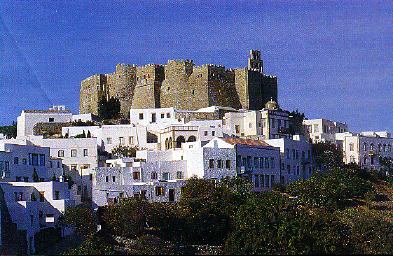

Patmos, like the other Dodecanese islands, is the result of ancient volcanic activity. And, like the others, it is small, only twenty-five miles in circumference (ten miles long and six miles wide at the widest point) with a mostly mountainous total area of fifteen square miles. Near the center of the island, Skala is the island's modern commercial center and port.
Populated today by some 2500 people who make their living from sponge diving and tourism, Patmos was largely deserted during the Middle Ages due in part to its vulnerability to Aegean pirates. It's earliest inhabitants, however, included Dorian and, later, Ionian settlers. In Roman times it may have served as a locale for exiled political dissidents, though, unlike on some neighboring islands, there is no remaining physical evidence of such use. Which brings us to the author of the Book of Revelations, who identified himself as "I, John, your brother who share with you in Jesus the persecution and the kingdom and the patient endurance, was on the island called Patmos because of the word of God and the testimony of Jesus" (Rev. 1:9 NRSV).
As far as anyone knows, Paul left no footprints on Patmos. The literary footprints are of the author of the Book of Revelation and what is to be seen today is largely the result of the island's identity with him. There is very little likelihood, incidentally, that John of Patmos was the author of the Gospel of John. Despite what guide books and tour guides would have you believe, his identity is something of a mystery. According to tradition, he was exiled to Patmos by the emperor Domitian in 95 CE for unspecified reasons. The Acts of John,a 5th-century work supposedly by the apostle's scribe, contains many legends about his time on Patmos.
The town of Pátmos (Khóra), up a winding road from the port, consists of the fortified Monastery of St. John the Divine surrounded by box-like houses that gleam white in the Aegean sun. Begun by St. Christodoulos in1088 at the behest of Emperor Alexius I Comnenus, the monastery contains a principal church plus five additional chapels. The
 | autonomy of the monastery was confirmed under Venetian rule (1207-1537); during the Turkish occupation (1537-1912) annual tribute was required from the monks. Today the Island is part of Greece and the monastery is maintained by Greek Orthodox monks who patiently watch tourists gawk at the splendors of their ancient home. |  |
 | The pride of the Monastery of St. John the Divine is its library or treasury, which contains one of the most important collections of monastic items in Greece, including embroidered stoles from the fifteenth to the eighteenth centuries, priceless icons, and silver-framed mosaics from the same period. More: precious illuminated manuscripts, church furniture from the seventeenth century, plus Benediction crosses in wooden filigree. And on top of the strictly religious items there is jewelry in the shape of ships worn by the wives of wealthy merchants. |
